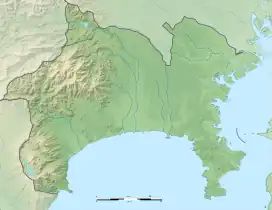| First Siege of Odawara | |||||||
|---|---|---|---|---|---|---|---|
| Part of Sengoku period | |||||||
 One corner tower of Odawara Castle today | |||||||
| |||||||
| Belligerents | |||||||
|
|
| ||||||
| Commanders and leaders | |||||||
|
Uesugi Kenshin Uesugi Norimasa Satomi Yoshihiro Oda Ujiharu Utsunomiya Hirotsuna Satake Yoshiaki Oyama Hidetsuna Nasu Suketane Ōta Sukemasa Mita Tsunahide Narita Nagayasu |
Hōjō Ujiyasu Hōjō Ujimasa Hōjō Ujiteru Hōjō Tsunashige | ||||||
| Strength | |||||||
| 90,000-113,000[1] | 15,000 | ||||||
 Location within Kanagawa Prefecture  Siege of Odawara (1561) (Japan) | |||||||
In the 1561 siege of Odawara, a battle of Japan's Sengoku period, Uesugi Kenshin attacked Odawara castle. This was the first of several sieges which would befall Odawara castle, the home castle of the Hōjō clan.
Background
In 1559, Kenshin was pushed once again by Uesugi Norimasa to take control of the Kantō back from the Hōjō, and in 1560 he was able to comply. In August of the same year, he put southern Echigo under control of a five-man council for broad mobilization, as well formed a small investigative council for any kind of unrest.[2] In 1561 he marched to Odawara.
Siege
Uesugi Kenshin was at the height of his campaign against the Hōjō clan, as he captured several of their castles. Kenshin was successful in taking a number of castles from the Hojo clan, like Numata Castle and Umayabashi Castle.[3]
Later, Kenshin besieged the Hōjō's main castle, Odawara Castle. The Uesugi breached the defenses, and burned the castle town. However, Kenshin would withdraw after two months. This came as the result of a lack of adequate supplies, and the reappearance of Takeda Shingen, Kenshin's long-time rival, who was threatening his territories.
Aftermath
The Odawara castle itself however remained unconquered; this ended the first of three sieges of the Odawara castle.
References
- ↑ "「関東の覇権を賭けて上杉謙信とバトル". Nonobono Hihonshi. 14 August 2021. Retrieved December 3, 2021.
- ↑ Goldsmith 2008, p. 211.
- ↑ Turnbull 1998, p. 89.
Sources
- Goldsmith, Brian (2008). Amassing Economies: The Medieval Origins of Early Modern Japan, 1450–1700. ISBN 9780549851158.
- Turnbull, Stephen (1998). 'The Samurai Sourcebook'. London: Cassell & Co.